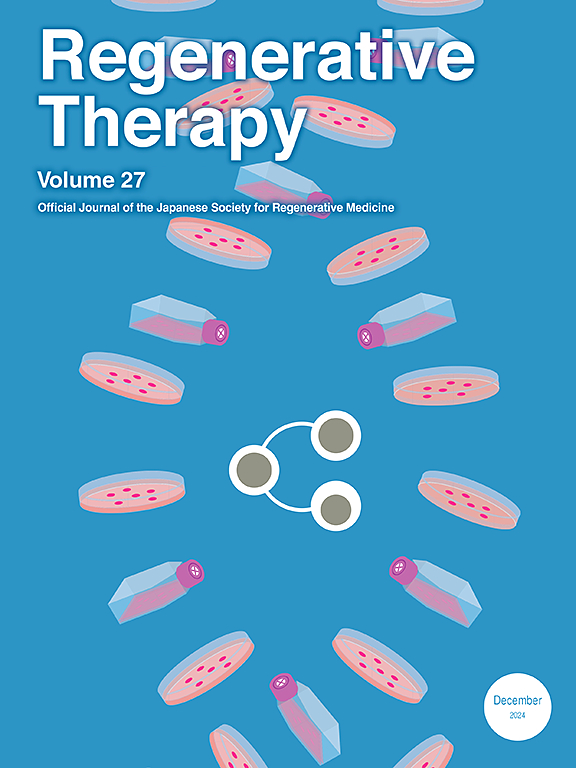富血小板血浆治疗膝关节骨关节炎:来自日本真实世界临床数据的见解
IF 3.5
3区 环境科学与生态学
Q3 CELL & TISSUE ENGINEERING
引用次数: 0
摘要
膝骨关节炎(KOA)非常普遍,富血小板血浆(PRP)治疗已成为一种新的治疗选择。尽管PRP很有前景,但其有效性仍存在争议。在日本,PRP治疗是在专门诊所进行的自费治疗。国家再生医学数据库(NRMD)的建立是为了支持对再生疗法的评估。本研究旨在分析在NRMD数据库中登记的我院KOA患者PRP治疗的特点及治疗效果,并找出影响治疗效果的因素。方法回顾性观察分析我院2020年1月至2024年5月在NRMD登记的KOA的PRP治疗资料。使用MyCells试剂盒制备低白细胞PRP (LP-PRP),患者每隔3至5周接受三次注射。入选标准包括对KOA保守治疗无反应的慢性膝关节疼痛。分别于治疗后3个月和6个月采集膝关节疼痛的视觉模拟评分(VAS)。统计分析包括配对t检验、逻辑回归和单因素方差分析(ANOVA)。结果共纳入患者2068例,膝关节2815个。平均年龄65.2岁,女性多于男性。PRP治疗可显著改善VAS评分,从基线时的53.5分提高至6个月时的35.8分(P <;0.05)。Kellgren-Lawrence (KL)分级为4级的患者比KL分级为2级和3级的患者改善更少。血中性粒细胞水平与疼痛严重程度呈正相关。VAS改善与年龄、体重指数(BMI)呈负相关。研究期间无重大不良事件报告。结论prp治疗KOA,在日本的临床环境中观察到,是一种安全的治疗选择,可以显著减少疼痛,特别是对于KOA畸形程度较轻的患者。然而,在严重畸形病例中,其有效性下降。这些真实世界的临床数据为完善患者选择标准和推进KOA治疗策略提供了有价值的见解。本文章由计算机程序翻译,如有差异,请以英文原文为准。
Platelet-rich plasma therapy for knee osteoarthritis: Insights from real-world clinical data in Japan
Introduction
Knee osteoarthritis (KOA) is highly prevalent, and platelet-rich plasma (PRP) therapy has emerged as a novel treatment option. Although PRP is promising, its effectiveness remains controversial. In Japan, PRP therapy is administered as a self-funded treatment in specialized clinics. The National Regenerative Medicine Database (NRMD) was established to support the evaluation of regenerative therapies. This study aimed to analyze patient characteristics and treatment outcomes of PRP therapy for KOA in our hospital registered in NRMD database and to identify factors that influence therapeutic effectiveness.
Methods
This retrospective observational study analyzed PRP treatment data for KOA in our hospital from January 2020 to May 2024 which was registered in the NRMD. Leukocyte-poor PRP (LP-PRP) was prepared using the MyCells kit, and patients received three injections at 3- to 5-week intervals. The eligibility criteria included chronic knee pain unresponsive to conservative treatment for KOA. Visual Analog Scale (VAS) for knee pain were collected at baseline and 3 and 6 months post-treatment. Statistical analyses included paired t-tests, logistic regression, and one-way analysis of variance (ANOVA).
Results
A total of 2068 patients (2815 knees) were included. The average age was 65.2 years, and there were more female than male patients. PRP therapy significantly improved the VAS scores from 53.5 at baseline to 35.8 at 6 months (P < 0.05). Patients with Kellgren-Lawrence (KL) grade 4 showed less improvement than those with KL grades 2 and 3. Blood neutrophil levels positively correlated with pain severity. VAS improvement negatively correlated with age and body mass index (BMI). No major adverse events were reported during the study period.
Conclusion
PRP therapy for KOA, as observed in the clinical setting in Japan, is a safe treatment option with significant pain reduction, particularly in patients with less severe deformity of KOA. However, its effectiveness decreases in severe deformity cases. These real-world clinical data provide valuable insights for refining the patient selection criteria and advancing KOA treatment strategies.
求助全文
通过发布文献求助,成功后即可免费获取论文全文。
去求助
来源期刊

Regenerative Therapy
Engineering-Biomedical Engineering
CiteScore
6.00
自引率
2.30%
发文量
106
审稿时长
49 days
期刊介绍:
Regenerative Therapy is the official peer-reviewed online journal of the Japanese Society for Regenerative Medicine.
Regenerative Therapy is a multidisciplinary journal that publishes original articles and reviews of basic research, clinical translation, industrial development, and regulatory issues focusing on stem cell biology, tissue engineering, and regenerative medicine.
 求助内容:
求助内容: 应助结果提醒方式:
应助结果提醒方式:


